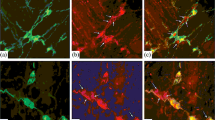Abstract
Immunoreactivity against vasoactive intestinal polypeptide (VIP), neurotensin (NT), substance P (SP), calcitonin gene-related peptide (CGRP), gastrin/cholecystokinin (GAS/CCK), somatostatin (SOM), serotonin (SER), and nitric oxide synthase (NOS) was investigated in the gastrointestinal tract of the urodele Ambystoma mexicanum, the axolotl, by the use of immunohistochemical techniques. The study also compares the distribution patterns and frequencies of the neurohormones, and NOS in neotenic and thyroxine-treated (metamorphosed) individuals. GAS/CCK, SP, NT, SOM, and SER immunoreactivities occurred in endocrine mucosal cells and VIP, SP, CGRP, NTSER, SER, and NOS immunoreactivities in the enteric nervous system. The GAS/CCK-immunoreactive (-IR) cells were restricted to the upper small intestine. NT-IR and SP-IR endocrine cells were found in the entire gastrointestinal tract and were most prominent in the distal large intestine. The density of the SOM-IR cells decreased from the stomach toward the large intestine. SER-IR endocrine cells were found throughout the gastrointestinal tract, with particularly high densities in the stomach and distal large intestine. The VIP-IR enteric nerve fibers were the most prominent ones, present in all layers of the entire gastrointestinal tract, and supplied the smooth muscle and the vasculature. The SER-IR fibers exhibited similar distribution patterns but were less numerous. Very few NT-IR but many SP-IR fibers were found in the muscle and submucosal layers. The NT-IR fibers mainly supplied blood vessels, while the SP-IR fibers were also in contact with the smooth muscle. In the muscle and submucosal layers, CGRP-IR fibers were associated to the vasculature; CGRP immunoreactivity occurred also in a minority of SP-IR fibers. NOS-IR nerve fibers were in contact with submucosal arteries but were the least frequent . After metamorphosis provoked by exogenous thyroxine, the number of SOM-IR endocrine cells in the stomach mucosa was increased as well as the density of VIP-IR, SER-IR, and SP-IR nerve fibers in the gastrointestinal tract. It is proposed that the observed increases may reflect refinements of the neurohormonal system after metamorphosis.
Similar content being viewed by others
Author information
Authors and Affiliations
Additional information
Received: 20 January 1999 / Accepted: 8 March 1999
Rights and permissions
About this article
Cite this article
Maake, C., Kloas, W., Szendefi, M. et al. Neurohormonal peptides, serotonin, and nitric oxide synthase in the enteric nervous system and endocrine cells of the gastrointestinal tract of neotenic and thyroid hormone-treated axolotls (Ambystoma mexicanum). Cell Tissue Res 297, 91–101 (1999). https://doi.org/10.1007/s004410051336
Issue Date:
DOI: https://doi.org/10.1007/s004410051336




